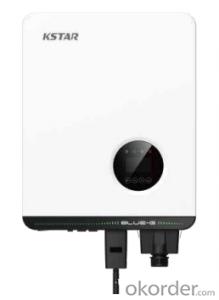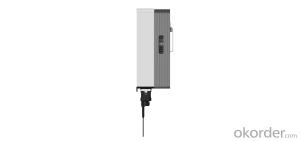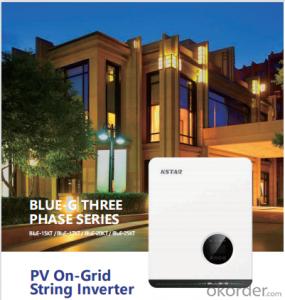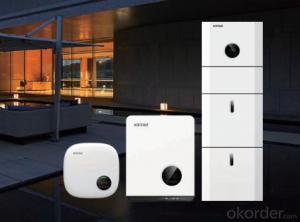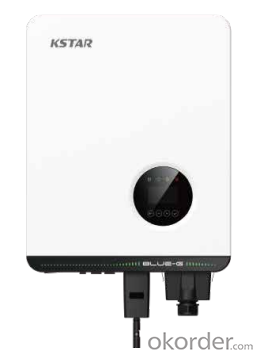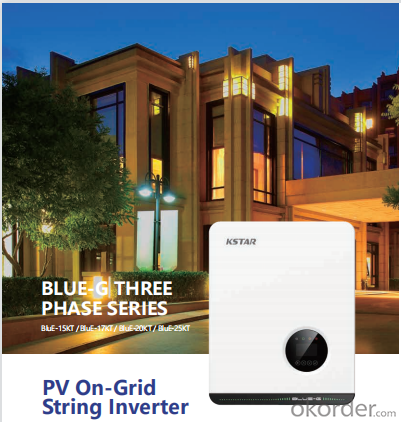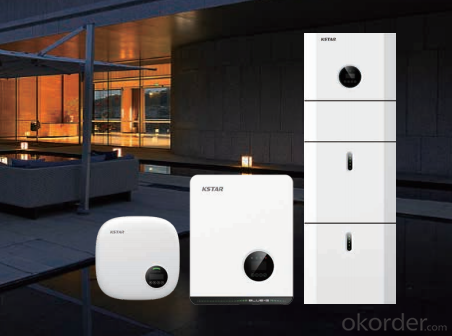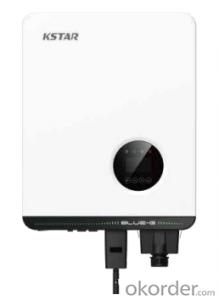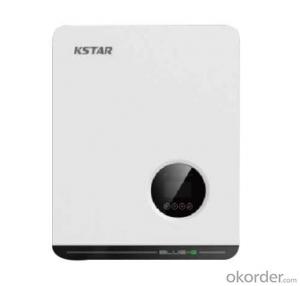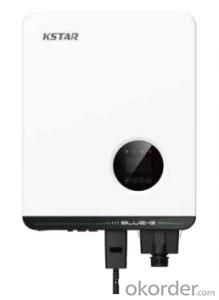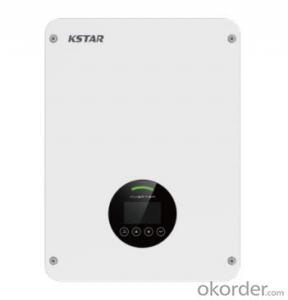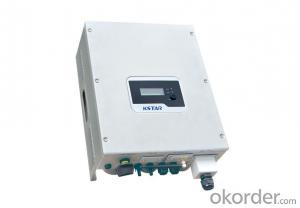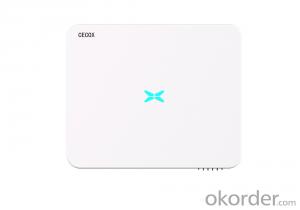72V Solar Inverter PV On-Grid String Inverter Blue-15kt / Blue-17kt / Blue-20kt / Blue-25kt
- Loading Port:
- China main port
- Payment Terms:
- TT OR LC
- Min Order Qty:
- 50 pc
- Supply Capability:
- 15000 pc/month
OKorder Service Pledge
OKorder Financial Service
You Might Also Like
Specification
Product Description:
★Max. PV voltage up to 1100V Type II DC /AC SPD
★Compatable for big capacity PV panel WiFi / 4G Plug optional
★DC/AC ratio up to 2 IP66 protection
★High efficiency up to 98.6% Smaller and lighter
Technical Specifications:
| MODEL | BluE-15KT | BluE-17KT | BluE-20KTL | BluE-25KTL |
| Input(DC) | ||||
| Max. DC Voltage | 1100V | 1100V | 1100V | 1100V |
| Nominal Voltage | 620V | 620V | 620V | 620V |
| Start Voltage | 180V | 180V | 180V | 180V |
| MPPT Voltage Range | 140V-1000V | 140V-1000V | 140V-1000V | 140V-1000V |
| Number of MPP Tracker | 2 | 2 | 2 | 2 |
| Strings Per MPP Tracker | 2/1 | 2 | 2 | 2 |
| Max. Input Current Per MPPT | 30A/15A | 30A | 30A | 30A |
| Max. Short-circuit Current per MPPT | 40A/20A | 40A | 40A | 40A |
| Output(AC) | ||||
| Nominal AC Output Power | 15000W | 17000W | 20000W | 25000W |
| Max. AC Output Power | 16500VA | 18700VA | 22000VA | 27500VA |
| Nominal AC Voltage | 400V 3L+N | |||
| AC Grid Frequency Range | 50Hz / 60Hz±5Hz | |||
| Max. Output Current (A) | 23.9A | 27.1A | 31.9A | 39.9A |
| Power Factor (cosφ ) | 0.8 leading to 0.8 lagging | |||
| THDi | <3% | |||
| Efficiency | ||||
| Max. Efficiency | 98.60% | 98.60% | 98.60% | 98.60% |
| Euro Efficiency | 98.20% | 98.30% | 98.30% | 98.30% |
| Protection devices | ||||
| DC Switch | Yes | |||
| Anti-islanding Protection | Yes | |||
| Output Over Current | Yes | |||
| DC Reverse Polarity Protection | Yes | |||
| String Fault Detection | Yes | |||
| AC/DC Surge Protection | DC: Type II / AC: Type III / Type II Optional | |||
| Insulation Detection | Yes | |||
| AC Short Circuit Protection | Yes | |||
| General Specifications | ||||
| Dimensions W x H x D (mm) | 380*483*193 | |||
| Weight(kg) | 25 | |||
| Environment | ||||
| Operating Temperature Range | –25℃~+60℃ | |||
| Cooling Type | Fan Cooling | |||
| Max. Operation Altitude | 4000m | |||
| Max. Operation Humidity | 0-100%(No Condensation) | |||
| AC Output Terminal Type | Quick Connector | |||
| IP Class | IP66 | |||
| Topology | Transformer-less | |||
| Communication Interface | RS485/WIFI/4G | |||
| Display | LCD | |||
| Certification & Standard | EN/IEC62109-1/2;IEC/EN61000-6-2;IEC/EN61000-6-4;IEC61683;IEC60068;IEC60529;IEC62116;IEC61727;EN50549-1;AS 4777.2;VDE-AR-N-4105;VDE 0126-1-1;CEI0-21;G98;G99;C10/C11;NB/T32004-2018;GB/T19964-2012 | |||
FAQ:
Q:How the output voltage of the PV inverter and the grid-connected voltage are determined
Inverter is the DC power (battery, battery) into alternating current (usually 220V, 50Hz sine wave). It consists of inverter bridge, control logic and filter circuit. Widely used in air conditioning, home theater, electric wheel, power tools, sewing machines, DVD, VCD, computer, TV, washing machine, range hood, refrigerator, video recorders, massage, fan, lighting and so on. In foreign countries
Q:Installation and maintenance of photovoltaic grid - connected inverter
only when the local power sector permission by the professional and technical personnel to complete all the electrical connection before the inverter can be connected.
Q:What is the difference between a PV grid-connected inverter and an off-grid inverter?
Off-grid inverter is equivalent to their own to establish an independent small power grid, mainly to control their own voltage, is a voltage source.
Q:After the PV inverter, how to achieve the same period before the network?
Solar panel simulator: with MPPT function, simulated morning, noon, afternoon, evening, rainy weather, solar panels produced under different conditions in different voltages.
Q:Is the PV inverter a current source or a voltage source?
According to the waveform modulation method can be divided into square wave inverter, stepped wave inverter, sine wave inverter and modular three-phase inverter.
Q:Photovoltaic grid-connected inverter without DC emc how will happen
Solar photovoltaic power generation technology is the use of solar cells, the photovoltaic effect of semiconductor materials, solar radiation can be directly converted into a new type of power generation system, solar energy is a radiant energy, solar power means --- to direct conversion of sunlight Into electricity,
Q:What is the difference between low voltage grid connection and medium voltage grid connection?
For photovoltaic power plants when the power system accidents or disturbances caused by photovoltaic power plant grid voltage drop, in a certain voltage drop range and time interval, the photovoltaic power plant can ensure that non-off-line continuous operation.
Q:Is the grid side of the grid and the inverter?
The grid load side of the grid is the grid. The inverter is an important part of the PV grid-connected system and can not be regarded as an external load. Photovoltaic power generation system is included in both grid and off-grid.
Q:PV grid-connected inverter and independent inverter in the control of what is the difference
The independent inverter in the output voltage phase amplitude of the frequency control is initially set good. Independent inverter, you should refer to off-grid inverter, do not need to consider the grid situation.
Product Images:
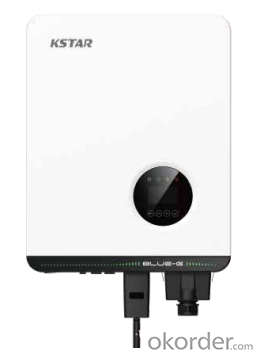
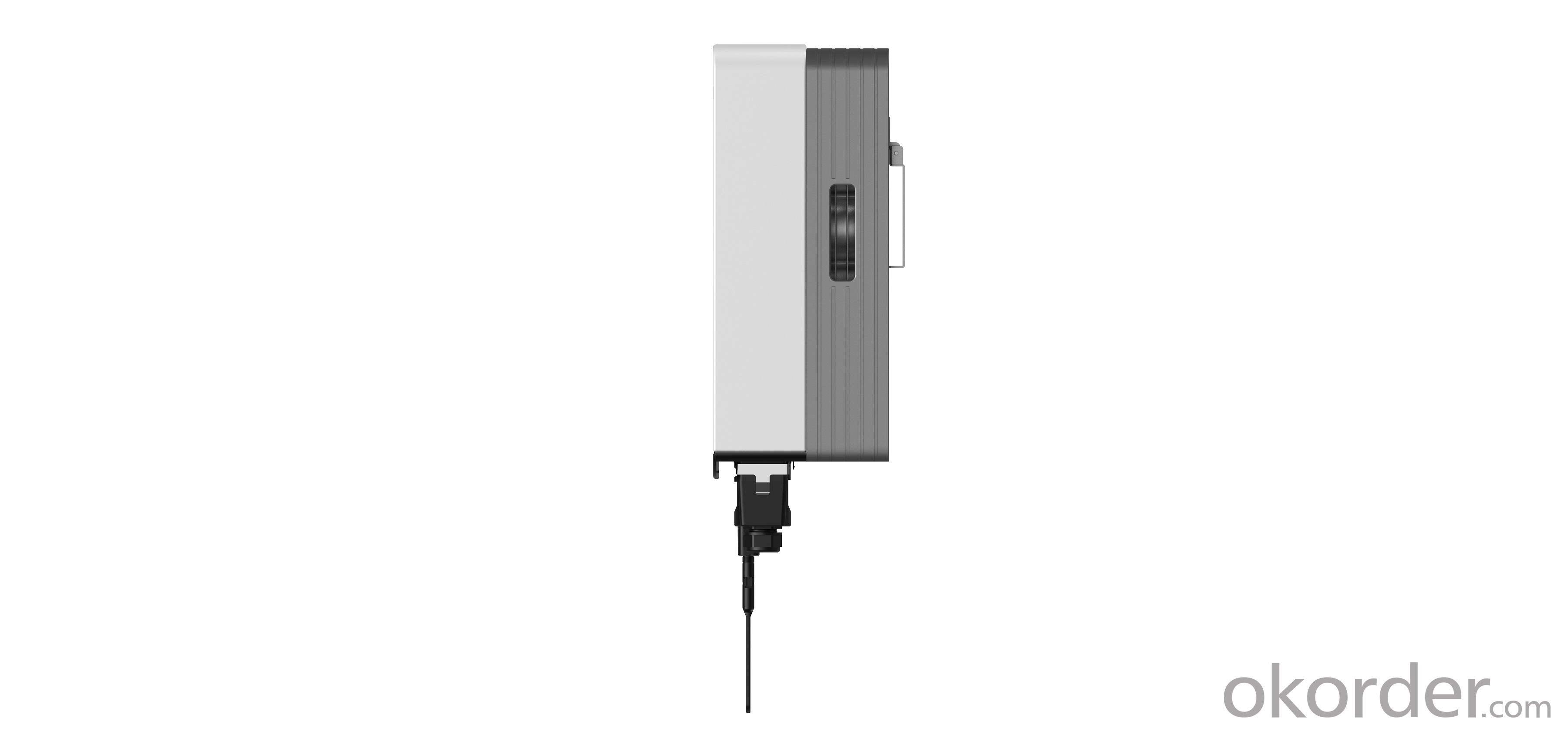
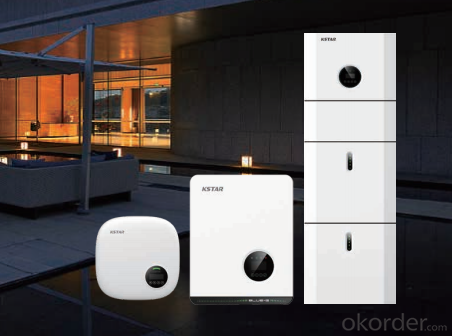
Production Process Photos:
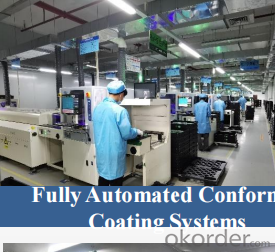
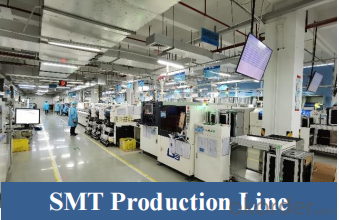
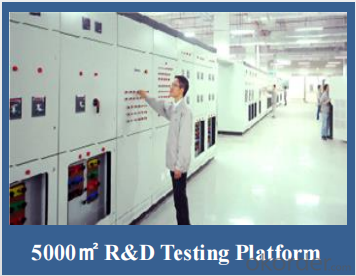
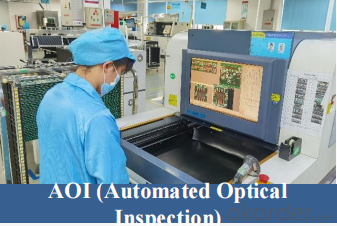
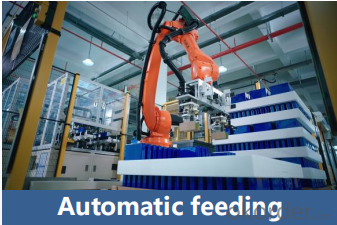
- Q: Can a solar inverter be used in a solar-powered desalination system?
- Yes, a solar inverter can be used in a solar-powered desalination system. A solar inverter is responsible for converting the direct current (DC) electricity generated by solar panels into alternating current (AC) electricity, which is required for the operation of the desalination system. By utilizing a solar inverter, the system can effectively harness solar energy and convert it into usable power for the desalination process.
- Q: What is the lifespan of the capacitors in a solar inverter?
- The lifespan of capacitors in a solar inverter can vary depending on several factors such as the quality of the capacitors, the operating conditions, and the overall design of the inverter. However, on average, high-quality capacitors in a well-designed solar inverter can have a lifespan of around 10 to 15 years. Regular maintenance and proper usage can help extend the lifespan of the capacitors in a solar inverter.
- Q: What is the role of a solar inverter in power quality management?
- The role of a solar inverter in power quality management is to convert the direct current (DC) generated by solar panels into alternating current (AC) suitable for use in the electrical grid. In addition to this primary function, solar inverters also play a crucial role in managing and maintaining power quality by ensuring a stable voltage and frequency output, reducing harmonics and reactive power, and providing grid support functions such as voltage regulation and power factor correction.
- Q: What is the maximum power capacity that a solar inverter can handle?
- The maximum power capacity that a solar inverter can handle depends on its specific model and design. In general, solar inverters range in power capacities from a few hundred watts to several megawatts.
- Q: Can a solar inverter be used with different types of tracking algorithms?
- Yes, a solar inverter can be used with different types of tracking algorithms. The inverter is designed to convert the DC power generated by solar panels into usable AC power for various applications. The tracking algorithm, on the other hand, is responsible for optimizing the solar panel's orientation to maximize energy production. Different tracking algorithms like fixed tilt, single-axis, or dual-axis can be employed with the solar inverter to enhance energy harvesting based on factors such as sun's position, time of day, and weather conditions.
- Q: Can a solar inverter be used with different types of grid connection standards?
- Yes, a solar inverter can be used with different types of grid connection standards. Solar inverters are designed to convert the direct current (DC) produced by solar panels into alternating current (AC) that is compatible with the electrical grid. They are versatile and can be programmed to work with various grid connection standards, such as single-phase or three-phase systems, different voltage levels, and frequency requirements. This allows solar inverters to be used in a wide range of grid configurations, making them adaptable to different regions and grid infrastructure.
- Q: What is the role of a solar inverter in a grid-tied system?
- The role of a solar inverter in a grid-tied system is to convert the direct current (DC) electricity generated by the solar panels into alternating current (AC) electricity that is compatible with the electrical grid. It also ensures the synchronization and stability of the solar power system with the grid, allowing excess energy to be fed back into the grid and enabling the system to draw power from the grid when needed.
- Q: What are the potential risks of overcharging a battery connected to a solar inverter?
- Overcharging a battery connected to a solar inverter can lead to several potential risks. One of the primary risks is a reduced lifespan of the battery. Overcharging can cause excessive heat and stress on the battery, leading to a shorter overall lifespan and reduced capacity over time. Another risk is the potential for thermal runaway or battery failure. Overcharging can cause the battery to become unstable, leading to a build-up of gases and potential leakage or explosion. Furthermore, overcharging can also result in increased maintenance costs. The battery may require frequent monitoring and maintenance to prevent overcharging, which can be time-consuming and costly. Lastly, overcharging can lead to inefficient energy storage. When a battery is overcharged, excess energy is wasted, reducing the overall efficiency of the solar energy system. To mitigate these risks, it is crucial to properly size and configure the solar inverter and battery system, ensuring that the battery is not subjected to excessive charging currents. Using appropriate charge controllers and monitoring systems can also help prevent overcharging and protect the battery from potential risks.
- Q: Solar grid inverter does not merge into the grid, direct access to the load to the load power supply?
- Widely used in air conditioning, home theater, electric wheel, power tools, sewing machines, DVD, VCD, computer, TV, washing machine, range hood, refrigerator, video recorders, massage, fan, lighting and so on.
- Q: Can a solar inverter be used with solar-powered ventilation systems?
- Yes, a solar inverter can be used with solar-powered ventilation systems. A solar inverter is responsible for converting the direct current (DC) produced by solar panels into alternating current (AC) that can be used to power various electrical devices, including ventilation systems. By connecting the solar panels to a solar inverter, the generated solar energy can be efficiently utilized to operate the ventilation system, ensuring a sustainable and eco-friendly ventilation solution.
Send your message to us
72V Solar Inverter PV On-Grid String Inverter Blue-15kt / Blue-17kt / Blue-20kt / Blue-25kt
- Loading Port:
- China main port
- Payment Terms:
- TT OR LC
- Min Order Qty:
- 50 pc
- Supply Capability:
- 15000 pc/month
OKorder Service Pledge
OKorder Financial Service
Similar products
Hot products
Hot Searches
Related keywords
